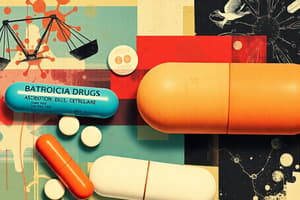Podcast
Questions and Answers
Which of the following bacteria can cross the blood-brain barrier?
Which of the following bacteria can cross the blood-brain barrier?
- Spirochetes
- Streptococci
- Pneumococci
- All of the above (correct)
Which of the following infections is NOT treated by benzathine penicillin G?
Which of the following infections is NOT treated by benzathine penicillin G?
- Syphilis
- Endocarditis
- Bacteremia
- Meningitis (correct)
Which penicillin has the highest oral bioavailability?
Which penicillin has the highest oral bioavailability?
- Penicillin V
- Ampicillin
- Amoxicillin (correct)
- Nafcillin
Which of the following infections is NOT treated by antistaphylococcal penicillins?
Which of the following infections is NOT treated by antistaphylococcal penicillins?
Which of the following is NOT a common cause of skin and soft tissue infections?
Which of the following is NOT a common cause of skin and soft tissue infections?
Which of the following infections is NOT treated by extended-spectrum penicillins?
Which of the following infections is NOT treated by extended-spectrum penicillins?
Which of the following is a contraindication for the use of carbapenems?
Which of the following is a contraindication for the use of carbapenems?
What is the MOST IMPORTANT cell wall inhibitor mentioned in the text?
What is the MOST IMPORTANT cell wall inhibitor mentioned in the text?
Which of the following is a true statement about the mechanism of action of vancomycin?
Which of the following is a true statement about the mechanism of action of vancomycin?
Which of the following is the ONLY Gram-negative activity of aztreonam?
Which of the following is the ONLY Gram-negative activity of aztreonam?
Which of the following is a true statement about the administration of vancomycin?
Which of the following is a true statement about the administration of vancomycin?
Which of the following is a true statement about the unintended effects of carbapenems?
Which of the following is a true statement about the unintended effects of carbapenems?
What is the primary difference between bactericidal and bacteriostatic agents?
What is the primary difference between bactericidal and bacteriostatic agents?
What is the primary advantage of using a combination of antimicrobial drugs?
What is the primary advantage of using a combination of antimicrobial drugs?
Which of the following is a common mechanism of antibiotic resistance?
Which of the following is a common mechanism of antibiotic resistance?
Which of the following is the most common mode of resistance to beta-lactam antibiotics?
Which of the following is the most common mode of resistance to beta-lactam antibiotics?
Which of the following is a common adverse effect of antimicrobial therapy?
Which of the following is a common adverse effect of antimicrobial therapy?
Which of the following is the primary reason for using a combination of antimicrobial drugs to treat tuberculosis?
Which of the following is the primary reason for using a combination of antimicrobial drugs to treat tuberculosis?
Which of the following is the most common mechanism of resistance to rifampin in Mycobacterium tuberculosis?
Which of the following is the most common mechanism of resistance to rifampin in Mycobacterium tuberculosis?
Which of the following is the primary reason for using a combination of a beta-lactam and an aminoglycoside antibiotic?
Which of the following is the primary reason for using a combination of a beta-lactam and an aminoglycoside antibiotic?
Which of the following is the most common mode of resistance to methicillin-resistant Staphylococcus aureus (MRSA)?
Which of the following is the most common mode of resistance to methicillin-resistant Staphylococcus aureus (MRSA)?
Which of the following is the primary disadvantage of using a combination of antimicrobial drugs?
Which of the following is the primary disadvantage of using a combination of antimicrobial drugs?
Which of the following is NOT a common side effect of penicillin antibiotics?
Which of the following is NOT a common side effect of penicillin antibiotics?
What is the mechanism of action of beta-lactam antibiotics?
What is the mechanism of action of beta-lactam antibiotics?
Which of the following bacteria is NOT susceptible to penicillin G?
Which of the following bacteria is NOT susceptible to penicillin G?
Which of the following penicillin antibiotics is administered as a long-acting intramuscular injection?
Which of the following penicillin antibiotics is administered as a long-acting intramuscular injection?
Which of the following antibiotics is considered a broad-spectrum antipseudomonal penicillin?
Which of the following antibiotics is considered a broad-spectrum antipseudomonal penicillin?
Which of the following statements about beta-lactam antibiotics is TRUE?
Which of the following statements about beta-lactam antibiotics is TRUE?
Which drug is considered the choice for gastroenteritis due to its bioavailability?
Which drug is considered the choice for gastroenteritis due to its bioavailability?
Which bacterium is an obligate anaerobe that most antibiotics do not treat?
Which bacterium is an obligate anaerobe that most antibiotics do not treat?
Which cephalosporin is primarily used for Neisseria Gonorrhea?
Which cephalosporin is primarily used for Neisseria Gonorrhea?
Which drug has the same activity as amoxicillin but with increased Gram-negative activity?
Which drug has the same activity as amoxicillin but with increased Gram-negative activity?
Which drug is the ONLY beta-lactam antibiotic that can treat MRSA?
Which drug is the ONLY beta-lactam antibiotic that can treat MRSA?
What is the primary mechanism of resistance to Beta-lactam antibiotics by Penicillin-resistant strep pneumoniae (PRSP)?
What is the primary mechanism of resistance to Beta-lactam antibiotics by Penicillin-resistant strep pneumoniae (PRSP)?
What makes cephalosporins particularly effective against staph infections?
What makes cephalosporins particularly effective against staph infections?
Which antibiotic is typically chosen for surgical prophylaxis, bone infections, and endocarditis due to its spectrum of activity?
Which antibiotic is typically chosen for surgical prophylaxis, bone infections, and endocarditis due to its spectrum of activity?
What is the common adverse effect associated with cephalosporin use?
What is the common adverse effect associated with cephalosporin use?
What aspect of cephalosporins makes them synergistic with aminoglycosides like gentamicin?
What aspect of cephalosporins makes them synergistic with aminoglycosides like gentamicin?




